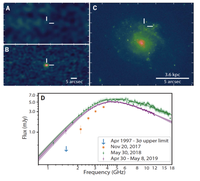A New Type of Radio Transient
 Comparison of images from the Very Large Array Sky Survey with older data from the Faint Images of the Radio Sky at Twenty-cm (FIRST) survey has revealed a new type of transient radio source, consistent with a merger-driven core collapse supernova. The source is associated with a soft gamma-ray burst detected in 2014 with the Monitor of All-sky X-ray Image (MAXI) instrument on the International Space Station.
Comparison of images from the Very Large Array Sky Survey with older data from the Faint Images of the Radio Sky at Twenty-cm (FIRST) survey has revealed a new type of transient radio source, consistent with a merger-driven core collapse supernova. The source is associated with a soft gamma-ray burst detected in 2014 with the Monitor of All-sky X-ray Image (MAXI) instrument on the International Space Station.
The new radio source is likely the result of a supernova driven by the collision between the neutron star or black hole companion of an evolved massive star. Such an event has been long theorized, but never before seen.
Image Caption: VT 1210+4956 was not detected in FIRST in1997 (A), but appears in the first epoch of the VLASS in 2017 (B). C shows the optical location in a dwarf galaxy at z = 0.035, and D shows the radio spectrum fit with a synchrotron self-absorption model.
Publication: D. Z. Dong (California Institute of Technology) et al., A transient radio source consistent with a merger-triggered core collapse supernova, Science, 373, 1125 (1 September 2021).
NRAO Press Release: Stellar Collision Triggers Supernova Explosion




Connect with NRAO